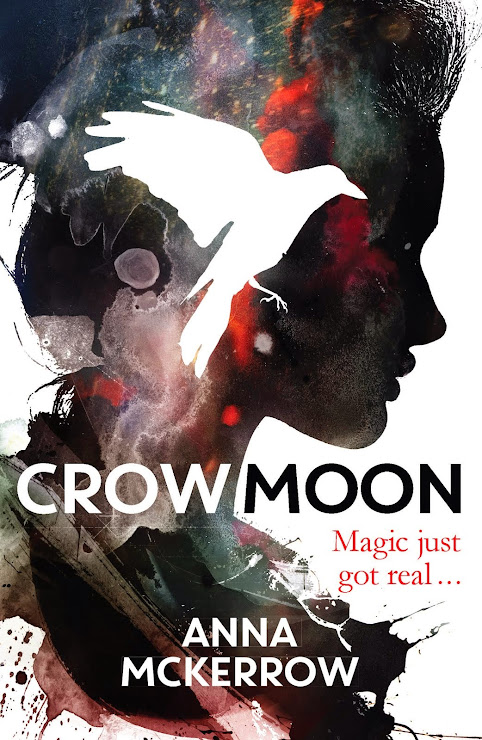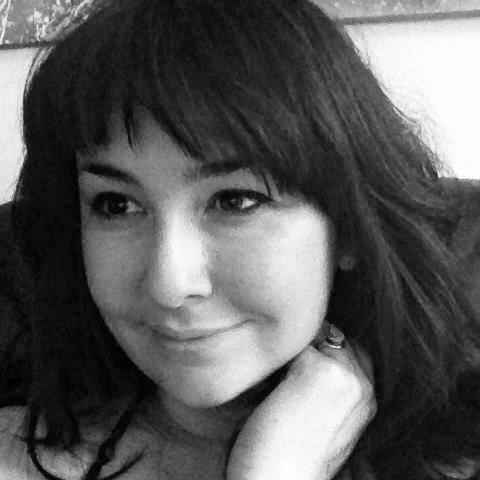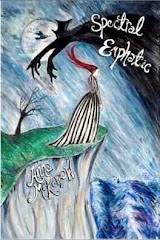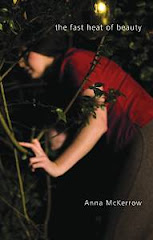Lucy Powrie very kindly hosted me as a special guest this week on #ukyachat to talk about representations of witches in children's fiction as well as revealing the cover of CROW MOON, which was very exciting indeed. Here's the cover:
Pretty!!!! Thanks Quercus! And, should you want to preorder the book, you can do it here. It's out on 5th March.
Anyway, like a massive nerd I had already made some notes around Lucy's questions but with the rapid fire nature of something like #ukyachat - I mean, I REALLY don't know how Lucy does it, she's amazing - there was a lot I didn't say, so here's a bit more stuff around the topics. For what it's worth.
I'm going to do another blog post about my top witchy book recommendations and my favourite witches in fiction another time.
QUESTION ONE: What are your favourite books about witches? How have they challenged the typical witchy stereotype?
Arha in book 2 of the Earthsea Quartet, the Tombs of Atuan. Technically she's a priestess of an old cult rather than a witch but the whole setup is ceremonial and devotional rather than potions and wands.
There's a lovely picture book for young readers called The Everyday Witch which is where a little boy wonders if his mum is a witch riding a broomstick etc and when he asks she explains she is a witch, but in the sense that she uses family wisdom to heal, knows about herbs etc.
The Witches of Eastwick, the book (though the film is great) the witches are normal women with more of a grasp of manipulating the natural world than supernatural beings.
I liked Laura Powell's Burn Mark which was a YA title where the main witch character was very east end, working class, and the witches were kind of petty criminals. Her nan had taught her all she knew. It was nice to read a rather unglamorous witch rather than the sirens one tends to get. There's a siren character in Crow Moon but lots of middle aged ladies and awkward kids too.
Most witch fitch, though, (my term - I invented it - me) reflects the historical misconceptions of wise women, and the continuing lack of understanding about either Wicca being all spells and potions or ideas about white and black witches, evil, sexy sirens and toothless hags, and also the idea that witches are born with power and not made from hard work, dedication and practice! So somehow the witch stays as a paranormal concept out of reach of the normal person rather than a skill and faith anyone could develop, and empower themselves with. People seems to be genuinely unaware that there is a huge pagan and modern witchcraft movement going on RIGHT NOW and that though those people might not be riding around on brooms, they are witches. People who in very real ways are working to positively influence their own lives and those of others.
On my most conspiracy theory days I would say that if popular culture tends to reflect the hegemony of the ruling elite, then it is in the interests of those that control us to maintain old superstitions and prejudices about concepts like the witch to discourage most people from pursuing enlightenment and gaining power for themselves. To keep imagining that magic isn't real.
My favourite novel specifically about a witch, a powerful woman, is The Sea Priestess by Dion Fortune. If you are remotely into witchy things you should read it.
QUESTION TWO: What affect do you think mythology can have on the way a story is told?
Stories that draw on mythology always appeal to me because of that depth of meaning they draw on, a resonance of cultural memory, symbolism, jungian collective imagery. Tolkien based LOTR on existing mythology which is partly why I think it has such a strong resonance with us still. Narnia too, which is deep in Christian mysticism. Mythology (in my view) enables us to connect to the spiritual journey of the soul, in allegory, in symbol, to give a story deeper understanding. I keep coming back to "resonance".
Mythology comes up in so many children's and young adult stories too, because I think on one hand children are immersed in legend and fable via fairytale so it's all current for them anyway, and on the other, it's a way to impart deep meaning in an apparently simple way. And I think writers are generally fascinated with myth, and want to work with it, refashion it, share what they love. I loved Bone Jack by Sara Crowe, which is the chasing the stag myth, the old pagan idea about the stag as the symbol of masculine energy, the sun and the earth, being sacrificed for a good crop, for the good of the land. And she reflects in that about how the stag chase needs to happen even more so, that maybe today we need to honour the earth more than ever before because it's sick, it's suffering. We don't honour the natural cycles anymore, and if we did, you can say for damn sure that we wouldn't be messing up the environment.
I'm really looking forward to Lu Herseys Deep Water, as that's a selkie myth. Margo Lanagan did one too - Sea Hearts. I also love anything with mermaids. I love the mermaid and siren myths. Basically I love all mythology. I would, I'm a pagan.
QUESTION THREE: Crow Moon focuses on pagan teenagers. How important do you think it is for religion to be represented in YA?
I think it is - lots of people live in religious cultures, families, in the UK, and just because many households are more secular, or atheist, that shouldn't be the accepted norm in books. Again it's a diversity issue. Wicca and paganism are very popular with teens, and there are lots of teen Muslims, teen Christians , teen Jews, teen Catholics etc etc. Religion and faith is a big part of life for lots of people and is under-represented in all fictional media. Again, specifically for pagans, it can be annoying when the only representations of your faith practice are only this completely fictionalised lightning-from-fingertip thing, or evil hags. I mean, I like a pointy black hat as much as the next person, but I think it reflects an unfortunate assumption certainly in the UK that anything spiritual is a bit silly, and if those people were being rational they'd be atheists.
And now more than at any other time is the need for us to be talking about faith and representing it in a variety of ways, talking about the issues within it, the deep questions. I think it can be hard to work it seamlessly into fiction without sounding preachy or evangelical, or alternatively very negative. But actually one of the things YA does really well is consider the big issues - coming out, gender identity, race, bullying, growing up, friends, family. So I think it's a good place to see more representations of religion and faith.It doesn't have to be ABOUT religion. Faith can just be there in the background, sometimes.
QUESTION FOUR: Have you read any cli-fi? Do you think there will be a rise in them as their relevance increases?
I think so. With clifi it's the same challenge about not making the prose clunky with all the science, but on the other hand, scifi has been managing that one way or the other for a long time - I mean, some scifi is definitely for the scientists out there, some is a bit more accessible.
I thought Flight Behaviour by Barbara Kingsolver was very good, but even in that there were quite long passages about butterfly habits and classifications and stuff. I mean, I probably learnt a lot. Don't ask me about it now, mind. The MADDADDAM trilogy by Margaret Atwood is amazing, and it's chillingly relevant to where we are today in terms of genetic modification, food production, biochemical engineering, GM crops etc. Also, it's a cracking read.
But I think our common concerns are always reflected in fiction, and we are now very concerned about the environment. Just like the big dystopia epics are reflecting a worry about the rise of totalitarianism and government control, the divisions between rich and poor, power and disempowerment, like in The Hunger Games, I think we'll see more and more fiction thinking about climate change and environmental issues over the next few years. The longer story arc of the CROW MOON trilogy engages more and more with the energy crisis and the inevitable results of capitalism.
As the film 2012 klaxoned at us in mile high letters - WE WERE WARNED. Right before it goes really weird at the end and loses all sense of geographical logic.







